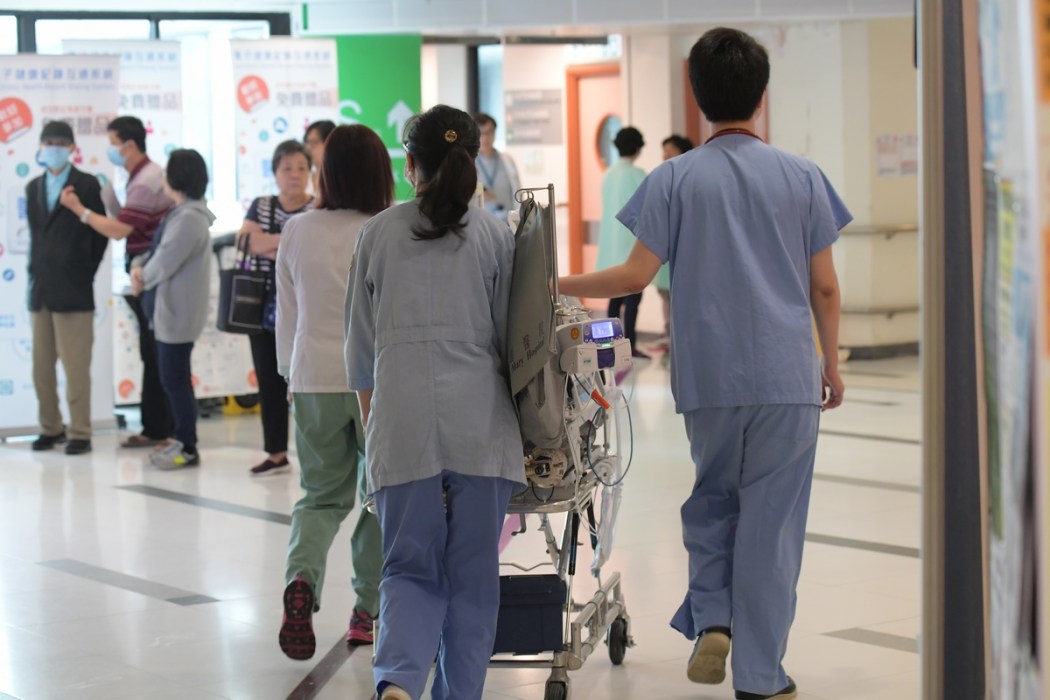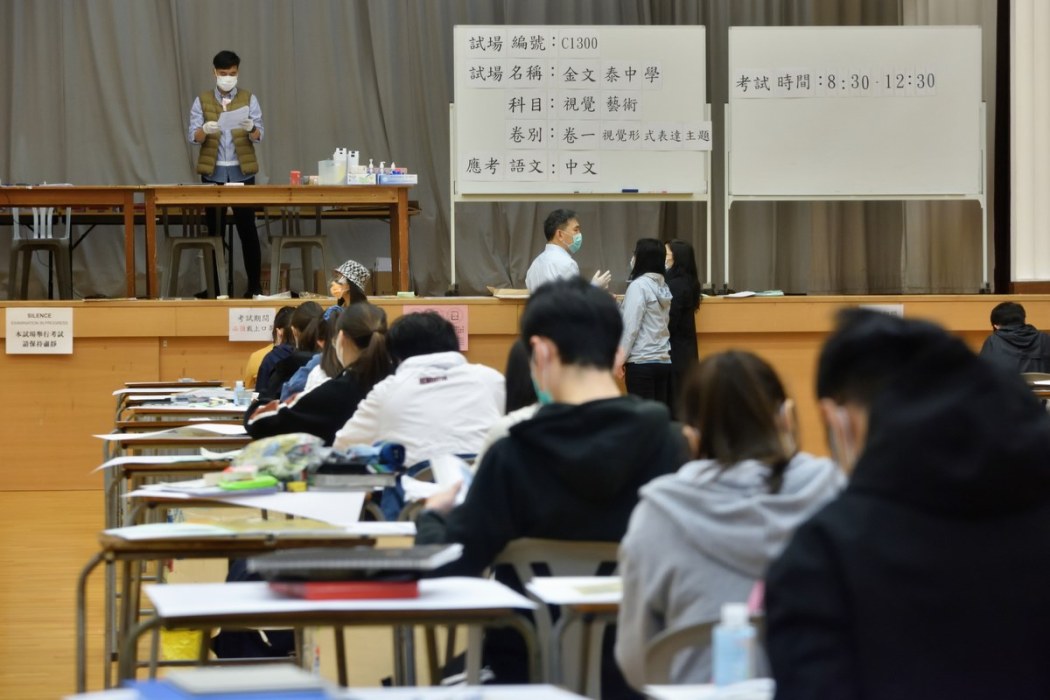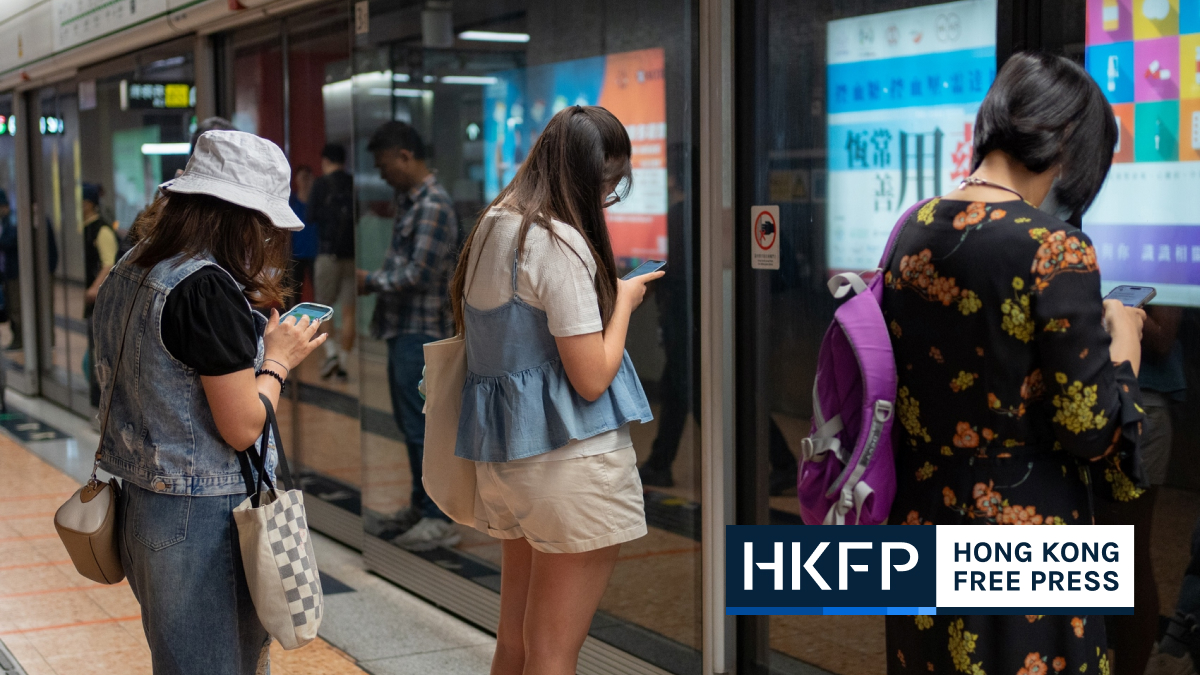By Maggie Holmes
Kaushiki Chaturvedi spent a Saturday morning in late March inspecting human body parts in a dissection lab. “It was kind of gory, but it didn’t smell that bad,” she said.

Kaushiki, a Form Four student at Creative Secondary School, was taking part at Med Start, a two-day programme at the University of Hong Kong (HKU) and the Chinese University of Hong Kong CUHK) designed to give secondary students a taster of life at medical school.
Academic lectures, campus tours and information on admission procedures are supplemented by the chance to wield a stethoscope in the clinical skills lab.
“I was already thinking about applying to medical school and these two days have made me more interested. Now I feel I have more options to study medicine in Hong Kong and don’t need to be as stressed about getting into a school in the UK,” Kaushiki told HKFP.
Kaushiki was one of five students from ethnic minority groups, whose MedStart course fees were subsidised by the DIMPLE Fund, an initiative which aims to encourage more non-Chinese students to apply for medical school.

Charlotte Ma, president of the Asian Medical Students’ Association Hong Kong, the student body which organises MedStart, says entrance to medical school seems an impossible dream for many students from ethnic minority groups.
“Low representation of ethnic minority staff in the healthcare sector creates the illusion that a career in medicine is hard to achieve,” she says.
Ma believes providing role models is an important first step to achieving wider ethnic diversity on campus and in the medical profession.
“We hope we can make ethnic minority doctors more visible, expose ethnic minority students to the healthcare sector and encourage more ethnic minority students to become doctors,” she says.

Hong Kong faces a serious shortage of doctors, with only two doctors per 1,000 people, compared to 2.8 in Singapore and three in European countries and North America. Recently the Chief Executive of the Hospital Authority Tony Ko led a team of health sector dignitaries to the UK to recruit non-locally trained doctors to work in Hong Kong.
This follows an amendment of the Medical Registration Ordinance in October 2021 which allowed graduates from 50 non-local medical schools to practise in the public health system.
Within a shrinking field, doctors from ethnic minority groups are even harder to find, especially in the public healthcare sector.
In a statement, the Hospital Authority (HA) said as an equal opportunities employer it does not hold statistics on the racial or ethnic identity of its employees. The HA employs 6,700 doctors across its 43 public hospitals and network of clinics – a browse through the staff lists reveals names that signal an overwhelmingly Chinese employee base.
Representation in public health care
The most recent government census showed that in 2021, Hong Kong’s ethnic minority population stood at 619,568 people – or 8.4 per cent of the total population – representing an increase of 37 per cent from a decade earlier. Some parts of the ethnic minority population rose more than others: the number of South Asians grew from 65,521 in 2011 to 101,969 in 2021, an increase of 56 per cent.

As such, Rohit Verma, a locally trained doctor, says more medical professionals from ethnic minority backgrounds are required to meet the needs of the growing ethnic minority population.
“Ethnic minority people have different socio-cultural views; they are looking for people that look like them, can speak their language and who they can trust to deliver their medical care.”
Verma, who speaks seven languages – including fluent Cantonese, Hindi, Sindhi and Urdu – says having a doctor from their own community can affect every aspect of a patient’s medical care.
“Often the older people in our community have limited health literacy; they don’t know the importance of taking medications, they might not show up to clinic or not want investigation. Poor communication can delay diagnosis, management, treatment – everything,” he says.

Verma stresses the importance of training ethnic minority medical professionals to work, and remain working, in the public sector.
“Many patients from ethnic minority groups… don’t know about the importance of insurance and can’t really afford private care, so there is an additional value for training local-born ethnic minority doctors,” he says.
Sukhdeep Singh is currently the only baptised and turbaned Sikh working as a doctor in Hong Kong’s public healthcare system. Fluent in Cantonese, he believes the healthcare sector has much to gain from a multilingual team of doctors.
“If there are more doctors who belong to different sub-communities in Hong Kong or speak multiple languages, a wider strata of patients can enjoy a better experience at public hospitals,” he says.

“Naturally, a Punjabi-speaking patient who speaks little Cantonese or English, will benefit from a doctor who speaks Punjabi,” he adds.
Cantonese a barrier, and a necessity
Aspiring medical students can choose to apply to the faculties of medicine at either HKU or CUHK.
The biggest challenge faced by students from ethnic minority backgrounds who are interested in studying medicine is the Chinese-language requirement.

HKU’s website states medical school applicants must have “a good working knowledge of Cantonese.” Prospective students must also demonstrate their Chinese-speaking ability during admission interviews.
Ivan Hung, clinical professor at HKU’s Department of Medicine, says Chinese-language skills are a necessity for medical students during their clinical training and when working in the local healthcare sector.
“We are bound by the patients we look after, who predominantly speak Cantonese. If you can’t communicate with them and you can’t take a proper medical history, that’s a major problem,” he says.
“It will be very difficult for us to accept candidates who cannot speak Chinese at all, even if they do very well academically or in the other parts of the interview.”

However, Hung points out that Chinese reading and writing skills are not required and lack of Chinese-language proficiency does not always lead to a closed door.
“There are exceptional cases where we admit students who can barely speak Cantonese or Mandarin and we help them with Cantonese language training during their pre-clinical years,” he says.
CUHK has a Chinese-language requirement for general admissions across the university, but Winnie Chu, an assistant dean of admissions, says the medical school offers a Chinese waiver, where necessary.
“[Lack of] Chinese does not affect a candidate’s chance to be admitted,” she says.
“Nevertheless, the faculty always emphasises the willingness of picking up Cantonese after admission, as students are expected to be ready for their ward duties at public hospitals in the future,” she says.

Chu says CUHK admits around 10 non-Chinese speaking medical students every year and provides them with Chinese-language training courses.
“From our experience, the tight bonding between our students, local or international, has proved to be the greatest help when it comes to adapting into local culture and picking up the language, ” she says.
Nandini Dulani is a second-year medical student at CUHK. She says the more relaxed language policy makes the CUHK medical programme more attractive to students from ethnic minority families.
However, she believes an overall lack of clarity about required levels of Chinese proficiency remains a huge obstacle to students from ethnic minority groups considering medical school in Hong Kong.
“I think a lot of ethnic minorities are very scared right now. If they cannot speak Chinese fluently, they wonder if they should even apply to medical school, and this fear really holds them back.”

Nandini speaks conversational Cantonese and intends to take Cantonese lessons over summer. Surrounding herself with Chinese speaking students at CUHK has also boosted her language skills.
“If you know you want to do medicine, don’t let the language barrier hold you back,” she advises.
Caught in a linguistic bind
Students from ethnic minority groups who are educated in the local system often find themselves caught in a linguistic bind. Those studying in schools that use Chinese for teaching may have the option of taking the Hong Kong Diploma of Secondary Education Examination (HKDSE) Chinese.
Passing HKDSE Chinese demonstrates a high level of Chinese language proficiency, but the exam is notoriously difficult and failure to achieve a high mark could rob students of the chance of entering medical school. A spokesperson for the Education Bureau (EDB) told HKFP that in the 2021-2022 school year, only 100 non-Chinese speaking students took the HKDSE Chinese paper, and out of them only around 20 students gained Level 3 or above – the mark generally accepted for admission to post-secondary education.
This represents a small population of the approximately 1,400 non-Chinese speaking students who studied in Form 6, during which the HKDSE is sat, that school year.

Theresa Cunanan, associate programme director at Hong Kong Baptist University’s College of International Education, says the current examination system creates a glass ceiling for students from ethnic minority groups who hope to go to university.
“There is no equity in the HKDSE programme for students; it’s a one-size-fits-all blanket curriculum. The HKDSE is hard for local Chinese kids, so it will be doubly hard for ethnic minority students who don’t have exposure to Chinese at home.”
Ethnic minority students attending schools that teach in English are taught Chinese as a second language and take alternative exams such as the General Certificate of Secondary Education.
Cunanan says this language pathway does not provide the level of language competency required for students hoping to work in professional fields such as medicine.
“It’s a lower calibre language qualification and I don’t think it’s going to be enough to speak, read and write Chinese at the required level,” she says.

Nandini Dulani agrees that systemic problems in the education system lead to under representation of students from ethnic minority backgrounds at medical school.
“I feel the whole education system is built to disadvantage us because we have Chinese as a second language,” she says.
“We are disadvantaged from the beginning, we are segregated at school, but when we get into the workforce, people say ‘that’s your fault’, the blame is on you – why don’t you know Chinese?”
An EDB spokesperson told HKFP: “As [non-Chinese speaking] students regard Hong Kong as their home, it is hoped that they will attain the Chinese proficiency level that could facilitate their integration into the local community.”
The spokesperson said student admission was a matter for government-funded universities to decide according to their own situations under institutional autonomy.

Despite CUHK’s more relaxed Chinese-language policy, ethnic minority students still form a tiny minority of medical undergraduates.
“I feel it is quite strange that I’m the only Indian student in the entire cohort,” says Nandini.
“There are so many young Indians of my age who I’m sure might be interested in medical school but the fact that there is only one out of 250 students doesn’t seem right,” she points out.
Marginalised in post-secondary education
The language requirement is not the only challenge facing students from ethnic minority groups hoping to attend university. Low rates of admission to medical school reflect a wider problem of under-representation of ethnic minority students in post-secondary education.
The 2021 census shows that close to 60 per cent of Hong Kong Indian students attended post-secondary education, while only 15.4 per cent of Thais went on to post-secondary education. The rate for Nepalese stands at 22.2 per cent, and Pakistanis at 25.1 per cent. The number falls further when migrant domestic workers are excluded.

Miron Bhowmik, assistant professor at the Education University of Hong Kong’s Department of Education Policy and Leadership, says Chinese-language proficiency is not the only factor at play.
“Our research shows ethnic minority students are sometimes doing pretty well in Chinese, but may not be doing well in subjects like mathematics, science or liberal studies [now Citizenship and Social Development]. Under-achievement is a complex process and is often the result of a combination of inter-related factors,” he says.
Bhowmik adds that students sometimes face problems of racial discrimination and the school environment fails to empower students to aim high.
“Some teachers have low expectations and we know that if teachers have low expectations that is going to impact the students’ educational achievements,” he says.
Negative perceptions about ethnic minority people in Hong Kong are a constant source of frustration for the community. Shalini Mahtani, founder and CEO of The Zubin Foundation, says these attitudes are at odds with the way South Asians are viewed overseas and are demoralising for ethnic minority students.
“In the UK and the US, we see that a significant percentage of doctors, specialists and consultants are South Asian, yet in Hong Kong we tend to assume ethnic minorities are not capable. But it’s the same population.”

The tide does appear to be turning. Mahtani says the community is starting to reach a “tipping point.” More students from ethnic minority groups are applying for university and The Zubin Foundation has seen a surge in applications to its scholarship programme.
“In the academic year, 2022-2023, we had over 200 applicants for 43 scholarships, compared to around 89 applications when the programme started three years ago. Things are changing and they are changing quite fast.”
‘A pool of untapped talent’
As Hong Kong faces the prospect of an ageing population coinciding with a shortage of healthcare workers, Mahtani views students from ethnic minority groups as “a pool of untapped talent.”
“Universities need to actively communicate their commitment by going into secondary schools and motivating ethnic minorities to apply for medicine, nursing and STEM subjects. They need to be putting ethnic minority faces on their websites, pamphlets and brochures,” she says.

The inclusion of ethnic minority students on university promotional materials may seem like a small step. However, locally trained physician Verma believes the presence of more ethnic minority doctors at medical school and in the local healthcare system can help change mindsets.
“It’s not just about making minority patients comfortable, it’s about improving our representation in the community,” he says.
Singh agrees. “I always hope that my patients and their relatives would see Sikhs in a better light after they received care from me. This can extend to their perception of South Asians and of foreign-looking individuals,” he says.
“I hope we can find ways to allow more passionate people to be given an opportunity to serve the people of Hong Kong.”
Support HKFP | Policies & Ethics | Error/typo? | Contact Us | Newsletter | Transparency & Annual Report | Apps
Help safeguard press freedom & keep HKFP free for all readers by supporting our team

LATEST FROM HKFP
HKFP has an impartial stance, transparent funding, and balanced coverage guided by an Ethics Code and Corrections Policy.
Support press freedom & help us surpass 1,000 monthly Patrons: 100% independent, governed by an ethics code & not-for-profit.










